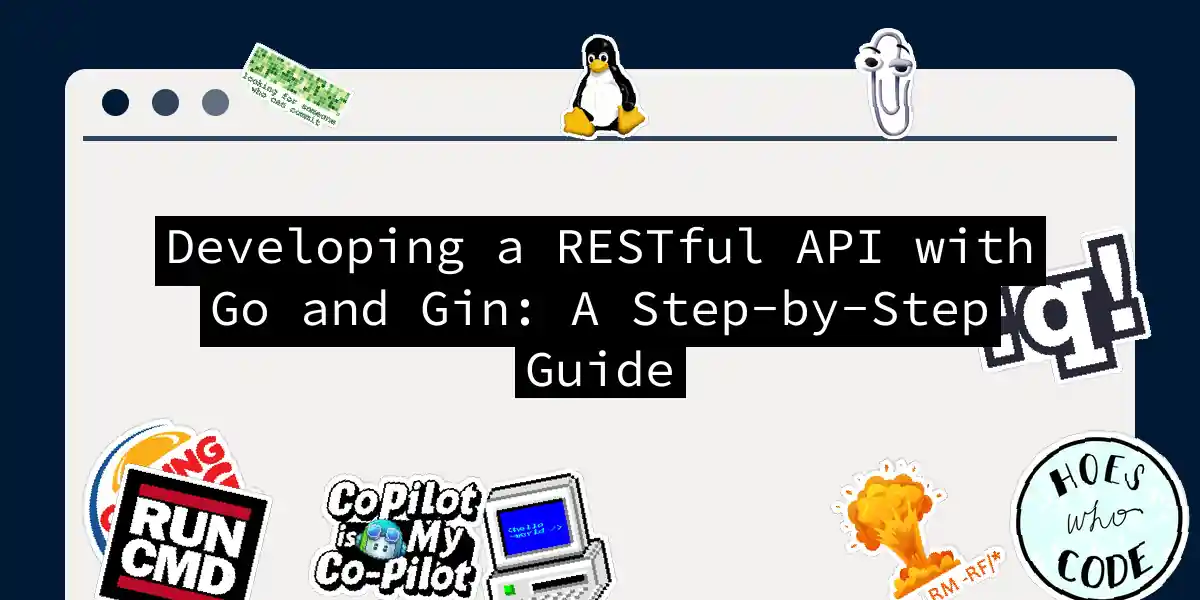Introduction to Go and Gin
When it comes to building RESTful APIs, the combination of Go (also known as Golang) and the Gin web framework is a powerhouse that can’t be ignored. Go, with its simplicity and high performance, and Gin, with its lightweight and robust features, make for a perfect duo in the world of web development.
Why Go and Gin?
Go is a modern language designed with concurrency in mind, making it ideal for handling multiple requests efficiently. Its goroutines and channels allow for scalable API development without the complexity often found in other languages. Gin, on the other hand, is a web framework that offers a Martini-like API but with performance up to 40 times faster than Martini.
Setting Up Your Environment
Before diving into the code, ensure you have the following prerequisites met:
- Install Go: Download and install Go from the official Go website if you haven’t already.
- IDE: Choose your favorite Integrated Development Environment (IDE) to edit your code. Popular choices include Visual Studio Code, IntelliJ IDEA, and Sublime Text.
- Postman: Install Postman or any other HTTP client to test your API endpoints.
- Gin Framework: You will need to install the Gin framework using the Go get command.
go get github.com/gin-gonic/gin
Creating Your First RESTful API
Let’s build a simple RESTful API to manage a collection of t-shirts. Here’s how you can do it step-by-step.
Step 1: Create the Project Directory and Files
Create a new directory for your project and navigate into it. Inside this directory, create a file named main.go.
mkdir tshirt-api
cd tshirt-api
touch main.go
Step 2: Write the Go Code
Open main.go and start by declaring the package and importing the necessary packages.
package main
import (
"net/http"
"github.com/gin-gonic/gin"
)
Step 3: Define the Data Structure
Define a struct to hold the t-shirt data.
type TShirt struct {
ID string `json:"id"`
Color string `json:"color"`
Ceremony string `json:"ceremony"`
Price float64 `json:"price"`
}
Step 4: Initialize Data and Handlers
Initialize some test data and create handlers for your API endpoints.
var tshirts = []TShirt{
{ID: "1", Color: "Red", Ceremony: "Wedding", Price: 20.99},
{ID: "2", Color: "Blue", Ceremony: "Birthday", Price: 15.99},
}
func getTShirts(c *gin.Context) {
c.IndentedJSON(http.StatusOK, tshirts)
}
func postTShirts(c *gin.Context) {
var newTShirt TShirt
if err := c.BindJSON(&newTShirt); err != nil {
c.JSON(http.StatusBadRequest, gin.H{"error": err.Error()})
return
}
tshirts = append(tshirts, newTShirt)
c.IndentedJSON(http.StatusCreated, newTShirt)
}
Step 5: Set Up the Router and Run the Server
Set up the Gin router and assign the handlers to their respective endpoints.
func main() {
router := gin.Default()
router.GET("/tshirts", getTShirts)
router.POST("/tshirts", postTShirts)
router.Run("localhost:8080")
}
Step 6: Run the Code
Run your API server using the following command:
go run main.go
You can now test your API using Postman or any other HTTP client.
Testing Your API
To test the GET /tshirts endpoint, send a GET request to http://localhost:8080/tshirts. You should receive a JSON response with the list of t-shirts.
To test the POST /tshirts endpoint, send a POST request to http://localhost:8080/tshirts with a JSON body containing the new t-shirt details.
{
"id": "3",
"color": "Green",
"ceremony": "Anniversary",
"price": 25.99
}
Handling Multiple Endpoints
Let’s expand our API to handle more endpoints. Here’s an example of how you can manage recipes with multiple endpoints.
Define the Data Structure and Handlers
Define structs for recipes and create handlers for CRUD operations.
type Recipe struct {
ID string `json:"id"`
Name string `json:"name"`
Ingredients []string `json:"ingredients"`
Instructions []string `json:"instructions"`
}
var recipes = []Recipe{
{ID: "1", Name: "Pasta", Ingredients: []string{"Pasta", "Tomato Sauce", "Cheese"}, Instructions: []string{"Boil pasta", "Heat sauce", "Combine"}},
}
func getRecipes(c *gin.Context) {
c.IndentedJSON(http.StatusOK, recipes)
}
func getRecipe(c *gin.Context) {
id := c.Param("id")
for _, recipe := range recipes {
if recipe.ID == id {
c.IndentedJSON(http.StatusOK, recipe)
return
}
}
c.JSON(http.StatusNotFound, gin.H{"error": "Recipe not found"})
}
func postRecipe(c *gin.Context) {
var newRecipe Recipe
if err := c.BindJSON(&newRecipe); err != nil {
c.JSON(http.StatusBadRequest, gin.H{"error": err.Error()})
return
}
recipes = append(recipes, newRecipe)
c.IndentedJSON(http.StatusCreated, newRecipe)
}
func putRecipe(c *gin.Context) {
id := c.Param("id")
var updatedRecipe Recipe
if err := c.BindJSON(&updatedRecipe); err != nil {
c.JSON(http.StatusBadRequest, gin.H{"error": err.Error()})
return
}
for i, recipe := range recipes {
if recipe.ID == id {
recipes[i] = updatedRecipe
c.IndentedJSON(http.StatusOK, updatedRecipe)
return
}
}
c.JSON(http.StatusNotFound, gin.H{"error": "Recipe not found"})
}
func deleteRecipe(c *gin.Context) {
id := c.Param("id")
for i, recipe := range recipes {
if recipe.ID == id {
recipes = append(recipes[:i], recipes[i+1:]...)
c.JSON(http.StatusNoContent, gin.H{})
return
}
}
c.JSON(http.StatusNotFound, gin.H{"error": "Recipe not found"})
}
Set Up the Router
Assign the handlers to their respective endpoints.
func main() {
router := gin.Default()
router.GET("/recipes", getRecipes)
router.GET("/recipes/:id", getRecipe)
router.POST("/recipes", postRecipe)
router.PUT("/recipes/:id", putRecipe)
router.DELETE("/recipes/:id", deleteRecipe)
router.Run("localhost:8080")
}
Using Gin’s Middleware and Error Handling
Gin provides robust middleware support and error handling mechanisms.
Middleware Example
Here’s an example of a simple middleware that logs each incoming request.
func loggingMiddleware(c *gin.Context) {
log.Println("Request from", c.ClientIP())
c.Next()
}
func main() {
router := gin.Default()
router.Use(loggingMiddleware)
// Register routes here
}
Error Handling Example
Gin allows you to handle errors elegantly using its error handling functions.
func main() {
router := gin.Default()
router.GET("/tshirts", getTShirts)
router.NoRoute(func(c *gin.Context) {
c.JSON(http.StatusNotFound, gin.H{"error": "Route not found"})
})
router.Run("localhost:8080")
}
Sequence Diagram for API Request
Here is a sequence diagram showing how an API request is handled using Gin:
Conclusion
Building a RESTful API with Go and Gin is a straightforward and efficient process. With Gin’s intuitive API and Go’s concurrency model, you can create scalable and high-performance APIs. This guide has walked you through the basics of setting up a RESTful API, handling multiple endpoints, using middleware, and error handling. Whether you’re building a simple API or a complex web service, Go and Gin are excellent choices to consider.
Happy coding
